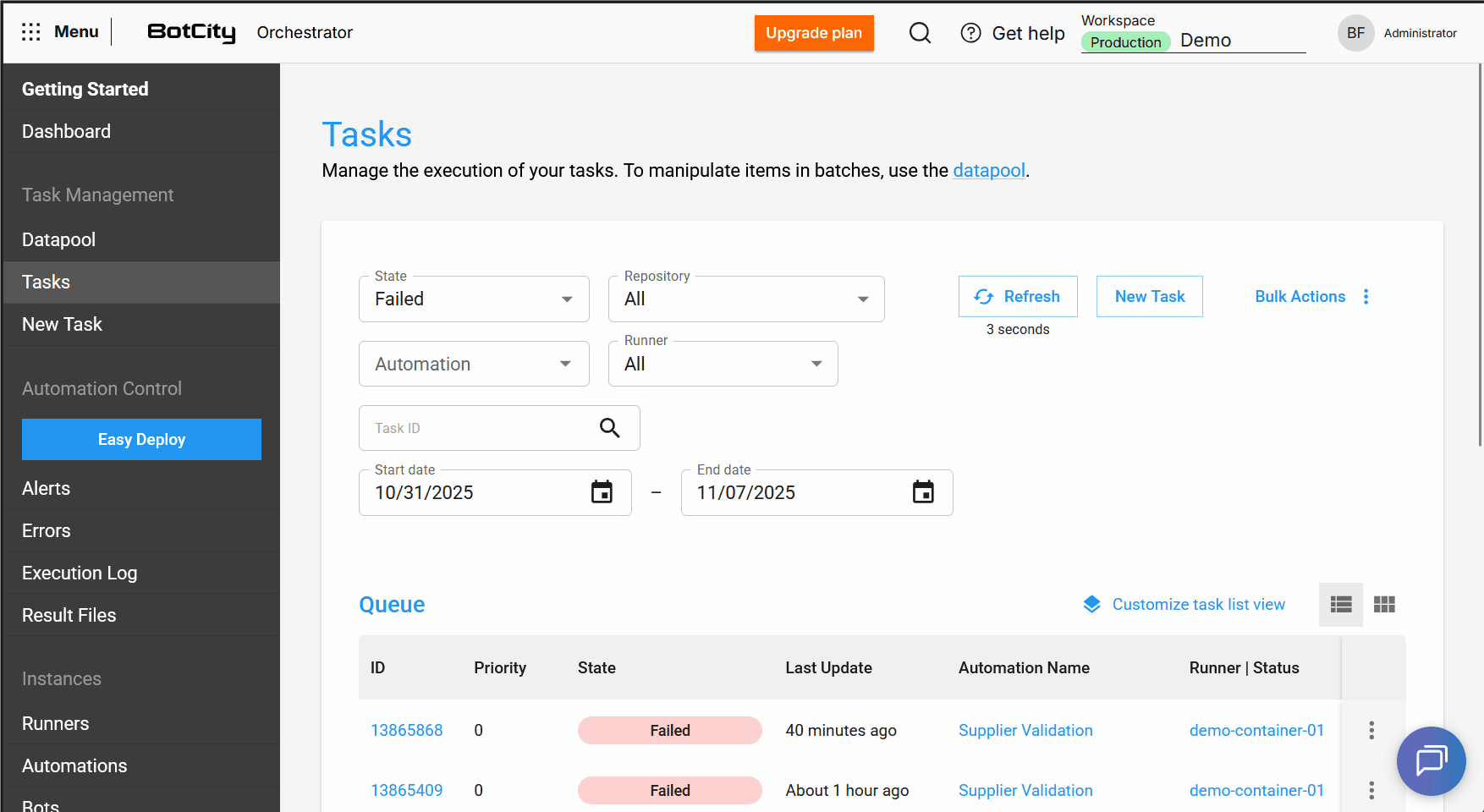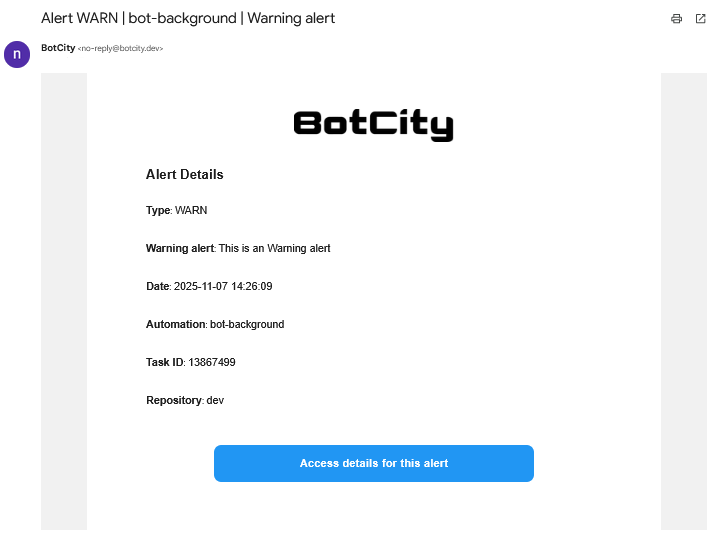January¶
Release | Erros e Alerts¶
This update introduces significant improvements to the Errors and Alerts functionalities:
-
Errors: New table with detailed fields, advanced filters, and improvements to the details page and the errors tab in Tasks, providing greater visibility and control.
-
Alerts: Redesigned page with improved listing, new filters, alert details, and functionalities such as notification management and URL sharing. Changes are also reflected in the alerts tab in Tasks and in notification emails.
These changes aim to optimize the user experience, making monitoring and troubleshooting more efficient.
Errors Feature¶
In this product version, we are implementing error visualization and management improvements.
With the new design, these enhancements give users greater visibility, control, and agility in resolving errors, making process management even more efficient. Below are the main updates:
Error Table¶
The new table includes the following data fields:
- Error ID: From now on, the user is taken, via a hyperlink implemented in the ID, directly to the error details page.
- Task ID: Displays the ID of the task associated with the error.
- Date: Displays the date and time the error occurred.
- Error Type: Details the type of error to the user.
- Message: Displays the message assigned to the error.
- Automation: Displays the Automation in which the error occurred.
- Version: Shows the latest version of the Bot and Automation deployment associated with the error.
Error Page Filters¶
Errors can now be filtered more efficiently using the following fields:
- Task ID Search: Allows you to search directly by the ID of the task where the error occurred.
- Automation Filter: With autocomplete support, allows the user to choose one or more automations to filter errors, listing them alphabetically.
- Period: Defines a time interval for filtering and analyzing errors.
Error Details Page¶
The details page has been enhanced to provide more information to users:
- Text Copy: Helps the user understand the features available in the error feature.
- Screenshot: If no image is generated, the user will be informed how to generate a screenshot via the documentation.
- Tags and Attachments: Users can now easily copy tag and attachment information related to the error.
Improvements in the Errors Tab within the Task Feature¶
In addition to the error table, the Errors tab now includes the following features:
- Table Columns—Similar to the Error feature screen, this tab mirrors the columns ID Error, Type Error, Date, and Message within Task information.
- ID Error - Links users directly to the error details page.
-
Additional Information in Task - Adds details about the Bot and Version of the deployment linked to the automation and the task.
-
Display of items in the table: Just like on the Errors screen, we also mirror the
Error ID,Date,Error Type, andMessagecolumns within the task information. - Error ID: Will take the user directly to the error details page.
- Additional information in Task: We added information about the
Botand theDeployment Versionlinked to the automation and the task.
Alerts Feature¶
In this new version of the BotCity Orchestrator, we are introducing the redesigned Alerts Page, specifically crafted to optimize alert monitoring and management in your operation.
This update features an intuitive design with informative cards, collaboration tools, and enhancements to encourage using this feature in your workflows. Below are the main improvements:
Alerts Page¶
The new page includes an updated listing for a more organized and user-friendly experience. This table contains:
- Alert Type: Allows the user to identify the alert type using a specific icon:
Error,Information, orWarning. - Alert Title as Hyperlink: Redirects the user to the alert details page.
- Message: Custom text entered by the user.
- Automation: Displays the Automation where the error occurred.
- Task ID: Identifies the task associated with the error.
- Date: Displays the date and time the alert occurred.
Available Filters¶
- Task ID: Allows direct searches using the task ID.
- Automation: Supports autocomplete, enabling users to select one or more automations to filter alerts.
- Period: Defines a date range for detailed analysis.
New Feature: Alert Details¶
This new feature provides detailed insights for analysis and action on alerts. Here's what's new:
- Alert Details: This section displays the alert type, title, and message.
- Automation Information: Shows data related to the automation, task ID, and associated repository.
- Alerts Notification: Displays a list of notified users who receive specific alert types within the automation.
New Functionalities¶
- Notification Management: Add or remove users who receive alerts for specific automation, with rules ensuring consistency in alert types.
- Share Button: Share the URL of an alert with team members.
Additional Improvements¶
The email notification for alerts has undergone changes to help users more quickly identify what type of alert has been triggered.








